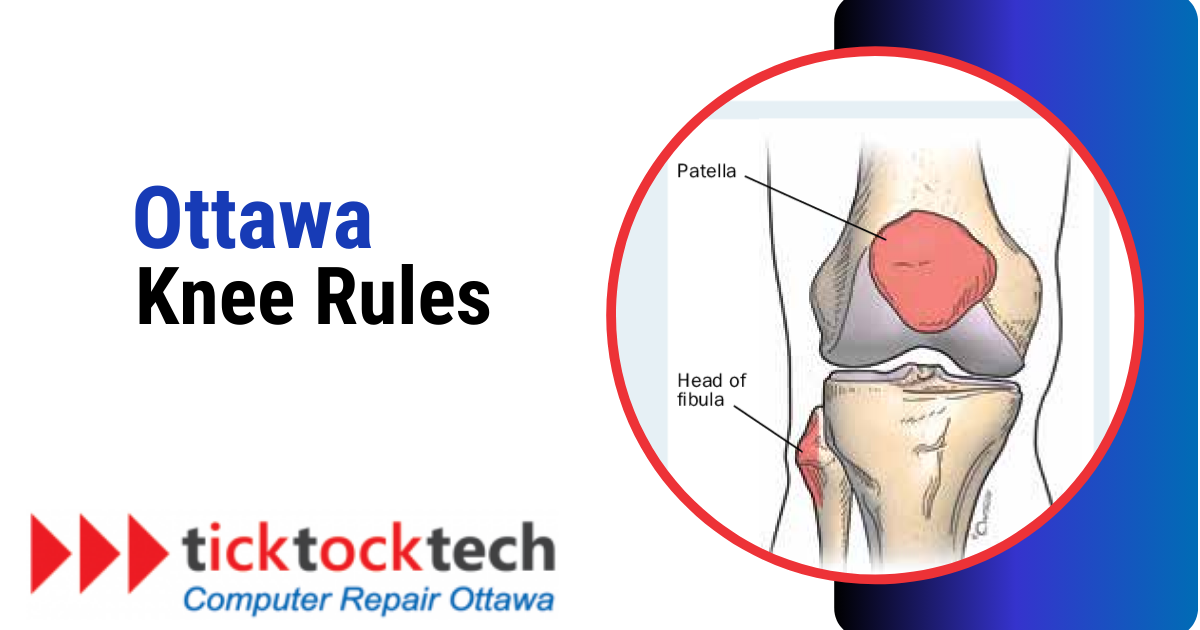Have you ever wondered how medical professionals determine when an X-ray is required following a knee injury? The Ottawa Knee Rules are more than just a set of guidelines; they are a streamlined system designed to reduce unnecessary radiation exposure and healthcare costs while maintaining high-quality patient care. Let’s take a quick look at what the Ottawa Knee Rules are, particularly if you’re not in the medical field.
What are the Ottawa Knee Rules?
The Ottawa Knee Rules are guidelines used to determine whether knee radiographs (X-rays) are required following knee trauma. Developed in Ottawa, Canada, these rules assist doctors in quickly determining whether a patient has a significant fracture. This is important because many knee radiographs ordered in emergency rooms may be unnecessary.
As per the National Library of Medicine. According to the rule, knee radiographs are indicated in these patients if at least one of the following criteria is met: the patient is at least 55 years old, cannot bear weight immediately after trauma, and is in the ED for four steps (regardless of limp), has isolated patellar tenderness, fibular head tenderness, or an inability to flex the knee to 90 degrees
These rules are intended to reduce unnecessary imaging, which is costly and frequently does not reveal any fractures. Using the Ottawa Knee Rules, healthcare providers can save money and time on unnecessary tests while still detecting important injuries. This ensures that only patients with a probable fracture receive radiographs, making the procedure more efficient and focused.
What Health Situation or Injury Does the Ottawa Knee Rules Solve
The Ottawa Knee Rules were created to deal with circumstances where there could be a knee fracture after trauma. They guide when to take X-rays of knee injuries. This aids in locating serious fractures that need medical attention right away.
The issue of adults getting needless knee radiographs following an injury is mostly resolved by these regulations. Physicians can rapidly ascertain whether a knee injury is likely to involve a fracture by applying these guidelines. This saves time and money on medical expenses by guaranteeing that radiography is only performed on patients who may have significant bone injuries.
The usefulness of these regulations for kids under the age of 18 is questionable, though. Research has yielded conflicting findings regarding their efficacy in pediatric patients. Therefore, until further conclusive research is available, it is advised against applying these guidelines to children.
Who Can Perform the Ottawa Knee Rule?
The Ottawa Knee Rule can be performed by healthcare professionals trained in evaluating knee injuries. This includes emergency room doctors, primary care physicians, and orthopedic surgeons. They apply these rules to determine whether knee X-rays are required following an injury. Their training enables them to perform the required physical assessments correctly, resulting in accurate and efficient patient care.
Related: What are Ottawa Ankle Rules?
Requirements for the Ottawa Knee Rules
The Ottawa Knee Rules specify when to perform X-rays based on certain criteria after a knee injury. These requirements include:
- Being 55 years or older.
- Feeling pain at the head of the fibula.
- Having pain solely on the kneecap (patella).
- An inability to bend the knee to 90 degrees.
- Being unable to bear weight, means not being able to take four steps immediately or while in the emergency department.
These guidelines help determine if there might be a serious knee fracture needing further examination.
How is the Ottawa Knee Rule Performed?
The Ottawa Knee Rules are implemented using specific assessments to determine the need for a knee X-ray:
Sensitivity Check: Palpation is used to assess the proximal fibula’s sensitivity.
Patella Examination: The patella is tested for sensitivity, not the surrounding tissues.
Knee Flexion Test: The examiner uses a goniometer to determine if the knee can flex to 90 degrees.
Position the goniometer axis on the lateral epicondyle of the femur. Align the stationary arm with the femur and point towards the greater trochanter. Also, position the moving arm along the fibula, pointing at the lateral malleolus.
Weight-Bearing Test: The ability to bear weight is determined by asking the patient if he or she can walk four steps immediately after injury. The patient is then seen taking four steps during the examination. If they are unable to walk four steps without pain, the test is positive.
A positive result in any of these assessments indicates the need for additional investigation, usually via radiographic imaging. This method makes it easier to identify significant knee injuries.
Festival: Ottawa Bluesfest Festival 2024, All You Need to Know
What are the Benefits of the Ottawa Knee Rules?
The Ottawa Knee Rules offer numerous advantages in clinical settings. First, they help to reduce unnecessary knee X-rays. This not only lowers healthcare costs but also reduces patients’ exposure to radiation. Using these guidelines, physicians can quickly determine whether an X-ray is required based on specific symptoms and injury characteristics. This efficiency accelerates decision-making in emergency departments, resulting in faster treatment for patients who require it and shorter wait times for those who do not. Overall, the Ottawa Knee Rules improve the efficiency of medical care by concentrating resources where they are most required.
Take Away
The Ottawa Knee Rules streamline emergency knee evaluations, ensuring that only necessary X-rays are taken. This system saves time, money, and radiation exposure, resulting in better patient care efficiency. These precise and practical guidelines help identify serious injuries quickly, making them invaluable in medical settings. Anyone involved in knee trauma care must understand and apply these rules.

